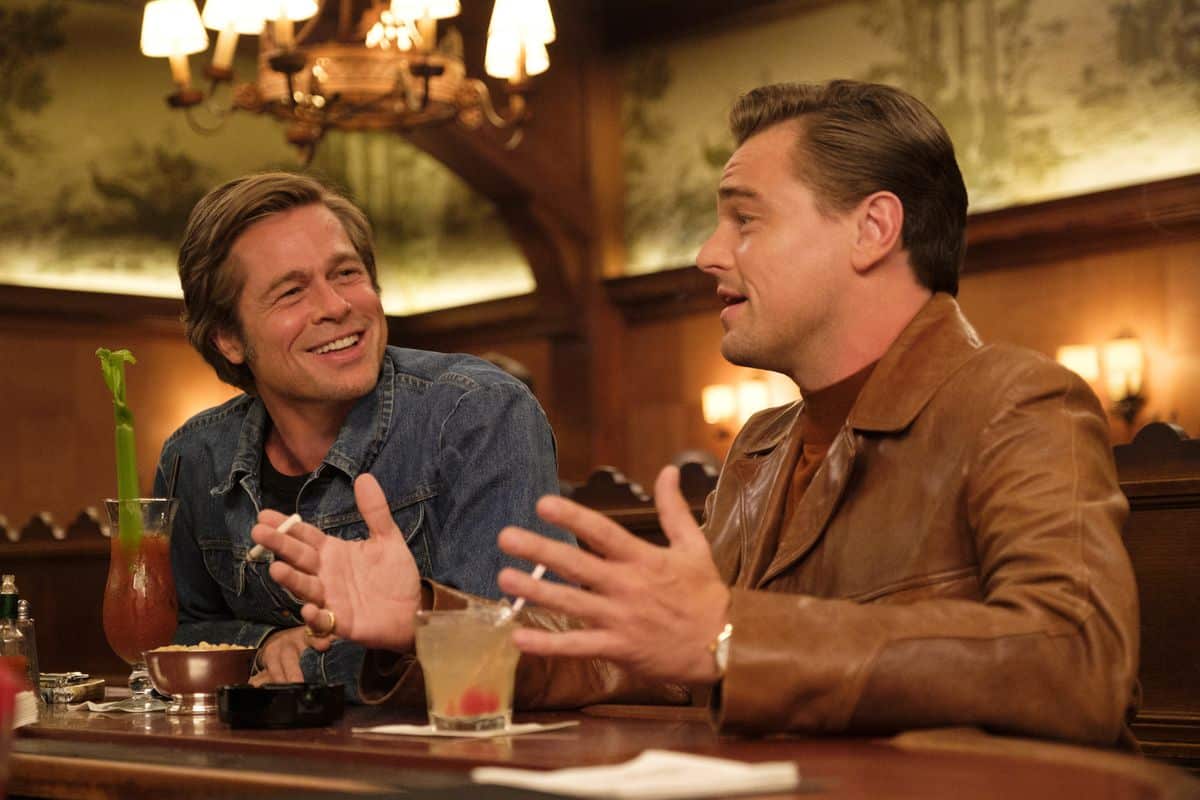Quentin Tarantino’s ninth film is a sun-soaked return to his roots, an energetic elegy for Old Hollywood that plays fast and loose with its history.
We don’t know yet whether Once Upon a Time in Hollywood will be Quentin Tarantino‘s penultimate film; he’s famously said he’ll retire after ten films, of which this is his ninth (and Lord knows if his rumored Star Trek film will ever materialize, or if anyone even wants it). But there’s an air of finality in his latest work that hints at a world-weariness, a wistful nostalgia for his prime and the Golden Age of Hollywood. It’s also one of his most atmospheric and assured films since Inglourious Basterds, which shares many of Hollywood‘s freewheeling attitudes toward the history it’s telling.
After a brief flirtation with Westerns and war, Once Upon a Time in Hollywood sees Tarantino back in the stomping grounds of his early career, a sunny, hyperreal Los Angeles populated by quick-witted characters with clever pottymouths. It’s 1969, and TV actor Rick Dalton (Leonardo DiCaprio) is facing a downward spiral with his career: once a promising young cowboy on an NBC show called Bounty Law, he’s found himself typecast as heavies, the kind of guy young upstarts beat up to prove their bona fides. Now, he drinks too much and wallows in self-pity, while relying on the generosity and labor of longtime stunt double, driver and best friend Cliff Booth (Brad Pitt) – himself persona non grata from the movie industry. For what? Well, as stunt driver Randy (Kurt Russell, possibly reprising his character from Death Proof) says… “Dude, he killed his wife.”
Their stories, of course, are just the angle by which Tarantino looks more broadly at the vibrant, larger-than-life tapestry of the late ’60s, a period he clearly has a lot of love for. Tarantino’s always been a collage artist, a man cobbling together new stories from shards of the odd bit of cult culture here and there, and Hollywood sees him fully embracing that mode with every meticulously-rendered fake film poster and period-appropriate costume.
There’s a whole alternate universe version of the ’60s on display, one in which Rick and Cliff have always existed on the margins, and which — like Inglourious Basterds, in more ways than one — rewrites history for a laugh. QT loves this era but doesn’t feel the need to treat it with undue reverence. It’s a playground on which he can paint his own picture of the time, an era in which the Westerns and spy capers of Old Hollywood were giving way to the youthful auteur energy of New Hollywood. What’s more, the free-love culture of the ’60s was about to end, courtesy of the Manson Family and the murder of one Sharon Tate (Margot Robbie).
While Hollywood plays fast and loose with its structure like so many of Tarantino’s works, it’s not an ensemble piece a la Pulp Fiction – here, the focus is firmly on Rick and Cliff’s respective stories, with a little attention paid on occasion to Sharon Tate’s everyday life. She’s barely a character in this, serving more as a bubbly icon of New Hollywood and existing in her own notoriety. While Rick’s career is on the outs, Sharon sneaks into a movie theater to watch herself in her first big break, The Wrecking Crew.
And yet, as we watch her watch herself on screen, we’re made acutely aware of the unreality of Tarantino’s world: Robbie-as-Tate watches the real Tate in the real Wrecking Crew. There’s no CG superimposing, no green-screen trickery. It’s an uncannily distancing move that positions his version of ’60s Hollywood as unlike that of the real deal. Perhaps the ellipsis that’s snuck into the film’s title (Once Upon a Time in… Hollywood) is a cheeky indicator that this is not the real Tinseltown we’re talking about. And yet, as we watch her unironically bask in the glow of the movie house, she serves as an avatar for the innocence of movie-watching, a joy Tarantino still holds dear.
Tarantino’s always been a collage artist, a man cobbling together new stories from shards of the odd bit of cult culture here and there, and Hollywood sees him fully embracing that mode.
This approach lets Tarantino cut loose, which is probably to the film’s benefit, especially as we center on DiCaprio and Pitt as his leads. It’s a bizarre thing to see former teen heartthrobs like these two suffer and flail about their closing careers, or to hear so many people call Pitt’s character “old.” (As one shirtless scene shows us, even old Pitt can still get it.) Of the two, Dalton has a harder time with it, his ego comically wrapped around the idea of his career fading. In one of his latest guest stints as a heavy on a Western, he connects briefly with his precocious eight-year-old co-star (an unstoppable Julia Butters) who reinvigorates his confidence as an actor, especially after an explosive breakdown in his trailer.
DiCaprio is having particularly garish fun here, ripping into his signature Jordan Belfort-era intensity and turning his washed-up TV star into a petulant, gurning child, as you do when you’re forced to contemplate cranking out spaghetti Westerns in Rome to keep your career afloat. On the other end of the spectrum is Pitt, all Southern drawl and stoicism, the kind of unstoppable Billy Jack figure who can fight to a draw with Bruce Lee (Mike Moh) and even hold his own in some tense confrontations with the Manson family. The two are gangbusters together, evincing even in their quiet moments the camaraderie of two men who’ve spent their lives together, Cliff being “more than a best friend and a little less than a wife” to Rick. They shine even when they split apart for their separate stories — Rick’s guest spot on Lancer and Cliff’s unexpected detour to the Manson Ranch — but each feels of a piece with the other.
As for the Mansons themselves, they play a much more peripheral part in Hollywood than one might expect from a gore-lover like Tarantino. Instead, they’re another layer to the gonzo tapestry he’s woven, a group of young nutcases who’ve taken over Spahn Ranch (where the fictional Bounty Law was shot) and who give the older Cliff no amount of discomfort. They’re a group of kids resentful of the largesse of Hollywood, who want to “kill the people who taught us to kill” through violent TV shows and movies; as one of cinema’s foremost purveyors of bloodshed, it’s a bold move for Tarantino to take.
And yet, that self-reflexivity beats at the heart of Once Upon a Time in Hollywood, a film made by a man who sees his own obsolescence coming. Just as Cliff and Rick barrel inexorably toward the “end of the trail” for their partnership and the era of Hollywood that would take them in, so too does Tarantino see the same for himself. It’s tempting to read it as an “old man yells at cloud” feature, with its characters’ many resentments toward young bucks taking their jobs. But it’s just as easy to imagine Tarantino owning up to the limitations of your age and range, instead tipping his hat and riding off into the sunset. He’s got one more film in him, but even if this were Tarantino’s swan song, it wouldn’t be a bad note to go out on.
**Also, it must be said that Tarantino’s been watching us clock his love of close-ups of women’s feet, and Hollywood literally shoves that predilection in our faces for almost the entire two-and-a-half-hour runtime. You can practically imagine QT telling us, “You think I liked feet before? Every lithe hippie girl from here to San Diego is going to prop up their little piggies on every dashboard and theater seat I throw in the foreground, and they’re gonna be filthy. And you’re going to like it.” What a way to turn a creepy crutch into a feature.
Once Upon a Time in Hollywood flies down LA highways in a souped-up Cadillac and into theaters July 26.

